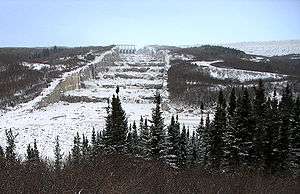Hydroelectricity in Canada
| Electricity generation in Canada |
|---|
 |
Canada is the world's second largest producer of hydroelectricity after China which is more than double Canada's level. [1] and one of few countries to generate the majority of its electricity from hydroelectricity (59% in 2006). In 2011, Canada consumed the equivalent of 85.2 megatonnes of oil of hydroelectricity, 10.8% of all the hydroelectricity generated in the world.[2] Some provinces and territories, such as British Columbia, Manitoba, Newfoundland and Labrador, Quebec and Yukon produce over 90% of their electricity in this manner. All of the dams with large reservoirs were completed before 1990, since then most development has been run-of-the-river both large and small. Natural Resources Canada calculates the current installed small hydro capacity is 3,400 MW, with an estimated potential of 15,000 MW.[3]
British Columbia
90% of BC Hydro's generation is produced by hydroelectric means. Natural gas and biomass thermal power round out the generation portfolio.[4]
Over 80% of BC Hydro's installed in generating capacity is at hydroelectric installations in the Peace and Columbia river basins. The GM Shrum and Peace Canyon generating stations on the Peace River produced 29% of BC Hydro's electricity requirements. In the Columbia River Basin, Mica and Revelstoke hydroelectric plants together contributed 25%, while Kootenay Canal and Seven Mile generating stations together supplied 10%.[4]
The remaining 25 hydroelectric generating stations supplied 14% of electricity production. BC Hydro also operates thermal power plants. The Burrard Thermal Generating Station contributes 7.5% and the remaining 14.5% of the electricity requirement was supplied by purchases and other transactions.[4]
Bc Hydro's last dam was completed in 1984, since then run-of-the-river projects with private partners have been built. Power production without reservoirs varies dramatically though the year, so older dams with large reservoirs, retain water and average out capacity. As of 2012 there were approximately 40 small hydro sites generating 750 MW. [5] By 2014 various companies have built a total of 100 run of the river projects under 50MW. In 2014 they produced 18,000 GWh from 4,500 MW of capacity.[6]
A second crown corporation, Columbia Power Corporation and two companies also own large dams in BC, Alcan's Kemano Project and FortisBC.
Manitoba Hydro
As of March 31, 2013, Manitoba Hydro serves a peak Manitoba electrical load of more than 4500 megawatts. Electrical supply to Manitoba customers was 21.5 terawatt-hours in fiscal 2013, with total revenue due to electricity of $1.733 billion CAD. Extraprovincial sales were at 9.1 terawatthours, with normal water flows. The company also delivered 2.05 billion cubic metres of natural gas in 2013, which contributed $573 million CAD to revenues.[22]
Newfoundland and Labrador
Newfoundland and Labrador Hydro's installed generating capacity, 7289 megawatts (MW), 80% hydroelectric, is the fourth largest of all utility companies in Canada.
Ontario Hydro
Ontario Hydro Has 40% hydroelectric, and 60% nuclear-powered facilities.
After a provincial government commitment to phase out all coal generating plants, two units at Nanticoke were shut down in fall 2010.[7] Another two were shut down in 2011.[8] The final four were shut down on December 31, 2013.[9]
Quebec
Hydro-Québec's extensive network of 61 hydroelectric dams have a combined capacity of 36,068 megawatts,[10] accounting for nearly half of the Canadian total. Hydropower accounts for 95.73%[11] of the supply sold by the Quebec state-owned utility. Five of Hydro-Québec's hydroelectric facilities are rated above 2,000 MW — the Manic-5, La Grande-4, La Grande-3 La Grande-2-A and Robert-Bourassa stations — while 7 others have a capacity of over 1,000 megawatts.[10]
Gallery
-

The Robert-Bourassa (LG-2) spillway, on Quebec's La Grande River.
-

Inside the Robert-Bourassa generating station powerhouse, the largest in North America with an installed capacity of 5,616 MW.
-

The Daniel-Johnson Dam, on Quebec's Manicouagan River (1968)
-

The 230-MW Rocher-de-Grand-Mère station, on Quebec's Saint-Maurice River (2004)
-

The 204-MW Rapide-Blanc generating station, on Quebec's Saint-Maurice River (1934)
-
A hydroelectric dam on the Arrow Lakes in British Columbia.
See also
References
- ↑ "BP Statistical Review of World Energy June 2014" (PDF). BP Global. BP. Retrieved 14 October 2014.
- ↑ "Statistical Review of World Energy June 2012" (PDF). bp.com. BP.
- ↑ https://www.nrcan.gc.ca/energy/renewable-electricity/small-hydropower/7363
- 1 2 3 ergy_in_bc/our_system/generation.html BC Hydro Generation System Retrieved 2012-03-05
- ↑ http://www.energybc.ca/profiles/runofriver.html#rorworld
- ↑ https://www.bchydro.com/energy-in-bc/acquiring_power/meeting_energy_needs/how_power_is_acquired.html
- ↑ Talaga, Tanya (3 September 2009). "Ontario shuts 4 coal-fired units". The Star (Toronto).
- ↑ "Ontario's Long-Term Energy Plan" (PDF). Government of Ontario. 2010. Retrieved 22 August 2012.
- ↑ "OPG'S NANTICOKE STATION STOPS BURNING COAL" (PDF). Ontario Power Generation. 2014. Retrieved 18 April 2014.
- 1 2 Hydro-Québec. Hydro Quebec: Annual Report, 2013 (pdf). Montreal.
- ↑ Hydro-Québec (2007). "Hydro-Québe's Electricity Facts: Energy Supplies and Air Emissions" (pdf). Retrieved 2009-05-06.
Further reading
- Desbiens, Caroline. Power from the North: Territory, Identity, and the Culture of Hydroelectricity in Quebec (2014)
- Froschauer, Karl. White gold: Hydroelectric Power in Canada. (Vancouver: UBC Press, 1999) excerpt and text search